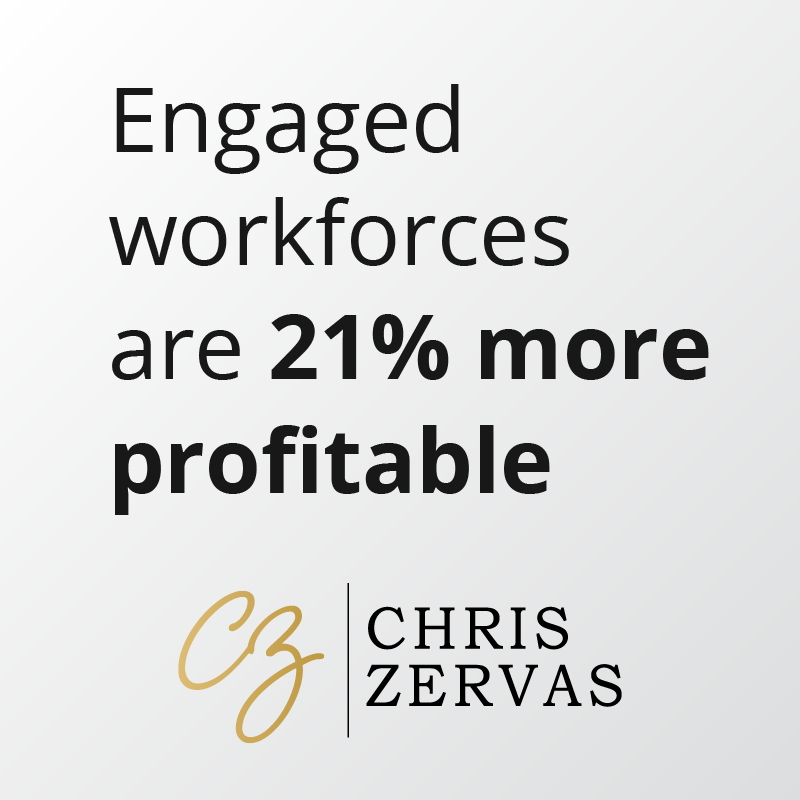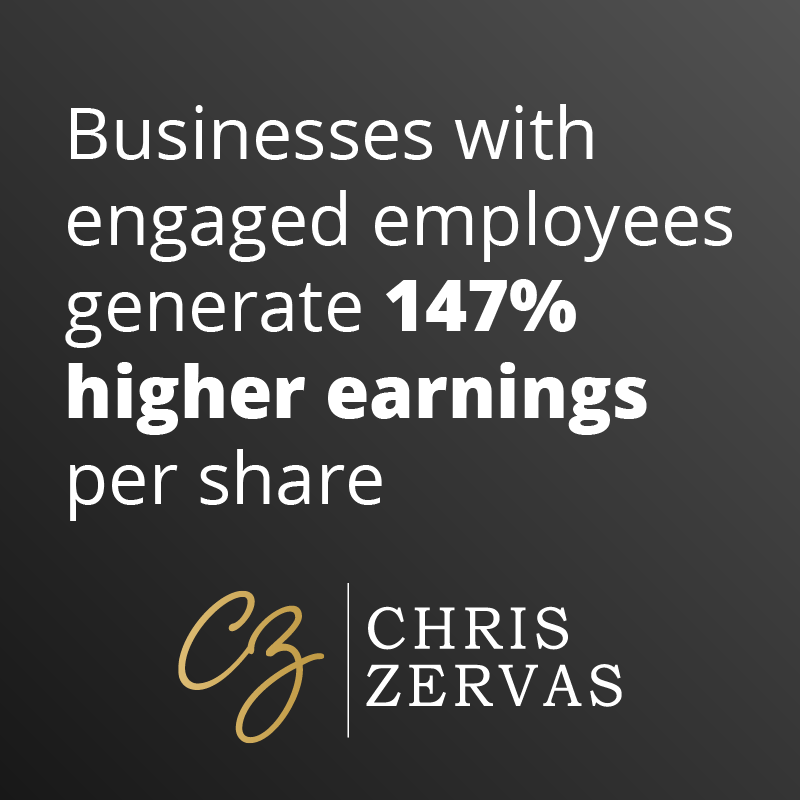
Here's what we'll cover:
It doesn’t matter in what line of work you’re in; you’ve almost certainly heard of the term “employee engagement.”
On the surface, it kind of feels like another overused bit of jargon that sounds fancy but ultimately doesn’t mean anything — probably just another box to tick on an employee survey, right?
Well, though it has been jargonized to a degree, that doesn’t make it any less impactful.
In reality, employee engagement could be better described as “company health,” because it uniquely affects every level of your business and without it, spells eventual collapse.
In fact, in one of the largest studies of its kind, Harvard Business Review’s 2013 study on employee engagement revealed that over 70% of executives at industry-leading organizations credited their engaged workforce as the source of their success.
With objective results like that, it’s hard to dispute the efficacy of engagement.
So let’s dive into employee engagement and learn what it truly is, what it isn’t, how it affects employees and employers alike, and how it affects every level of your business’s performance.
What Employee Engagement Is and Isn’t
Let’s first take a look at the term “employee engagement” itself and get at the heart of what it truly means, and more importantly, what it doesn’t mean. Equipped with this information, we’ll be able to see the direct link more easily between the engagement and the bottom-line business outcomes it produces.
What Employee Engagement Isn’t
Engagement is often confused with other similar-sounding terms like “satisfaction” or “happiness.”
And while the conflation of these terms is understandable, it’s in this fundamental misunderstanding of what engagement isn’t that time, money, and resources being thrown at trying to fix the symptoms of disengagement rather than addressing the root causes.
Employee engagement is not “employee satisfaction.”
The term that is most commonly conflated with employee engagement is “employee satisfaction,” and it’s easy to see why.
Naturally, when we think of someone who is satisfied with their workload, job, and role within a company, we assume they must be engaged with the work on some level, right?
If this has been your working understanding of engagement, don’t worry. This assumption trips up even the most seasoned managers and executives.
A good way to remember the difference between employee engagement and satisfaction is to reframe satisfaction as “contentedness.”
An employee can be perfectly content in coming in at 9, performing the minimum day-to-day of their job requirements, and then clocking out at 5.
This employee likely doesn’t have any strong beliefs about the company and its mission, and doesn’t see your customers as people with whom they build relationships and create bridges of trust.
They’re satisfied (content) with the work and its predictable routines. They’re satisfied (content) with the day-to-day, and they’re satisfied (content) with everything staying exactly as is.
This is a satisfied employee, but not one that’s engaged.
An engaged employee believes in the mission of your company, sees customers as people with whom they’re building trust-based relationships, and wants to further both themself as a professional and the vision of the organization.
Employee engagement is not “employee happiness.”
Conflating engagement with happiness is how the working world has found itself making comfort and excitement a priority — foosball tables, bean bag chairs, and other creature comforts — while still wondering why employee retention and overall company performance is slipping.
While an employee can be happy with their job — feeling happy in their role and in the service they perform for the good of others — that doesn’t mean they’re engaged.
For instance, a server at a restaurant may enjoy the nature of the work, the smiles they put on customers’ faces, and enjoy the camaraderie of their co-workers.
But, at the end of the day, they might downright detest everything about the restaurant brand they work for.
Whether it’s how the food is sourced, the business practices of the restaurant, or the vision of the executive leaders, this is an employee that’s happy at their job but is fundamentally at odds with the mission of the brand they represent.
No matter how many perks, rewards, or incentives are placed before this employee, they’re not likely to ever invest themselves deeply into its continued success or their future within that organization.
This employee is happy in their efforts and the fruits that their work bears, but they’re not engaged.
Employee Engagement is not “employee motivation.”
There’s no question that motivating your employees is important. It helps revitalize focus on key goals, can help employees feel noticed and appreciated, and can spur progress toward new levels of success.
But while it’s an important aspect of a high-performance workforce, motivation is inherently fleeting.
It’s easy to feel the meaning of your work and its impact when you’re in the middle of a motivating celebration, but it’s difficult to feel inspired and energized when you’re making an emergency 2:00 AM service call in the dead of winter.
It's in those trying times where true engagement — not the inevitably fading excitement of motivation — keeps influential executives, leaders, and team members going.
In those moments, being truly engaged allows us to see the deep-rooted connections between the day-in-day-out efforts we make and how those are related to a deeper mission — one which everyone in the company serves and believes — that makes a lasting and meaningful impact.

What is the definition of employee engagement?
Now that we can contrast employee engagement with the terms it’s often confused with, it’s much easier to get a clear picture of its true definition.
The definition of employee engagement is how emotionally committed your employees are to the goals and mission of your company and those it serves.
But as you can imagine, this isn’t something that occurs naturally, and it doesn’t take root by simply having your employees commit your business’s goals and mission to memory.
Ultimately, it’s the combination of several factors that take continuous work, vigilance, and thoughtful leadership to maintain.
"By making employee engagement a core focus of your business, you create success at every level of your business for employees, managers, executives, and even shareholders." Tweet
How to Create an Environment of Employee Engagement in Your Business
An engaged, passionate workforce is the ultimate competitive advantage you can have, but it can’t be something that’s forced or inauthentically incentivized. It takes time and a level of dedication that’s rare in both life and business.
For those who do commit to the investment however, their efforts and their organization are rewarded with a resilient and dependable workforce, a customer base of advocates, and unquestionable industry authority.
Let’s dive deeper and examine how to plant the seeds of engagement in your business and how to help them flourish.
Know the “why” of your business and the values it’s founded upon.
The “why” of a business is just that — why the company was founded.
Whether it was to serve a specific industry to a higher standard, help bring attention to a specific problem, or to simply be of help to a community of people, your “why” is what sustains you through the grueling hours and the business’s darkest times.
Most importantly, your why — and the set of values it's inextricably linked to — are the bedrock from which all action should stem. If there’s action being taken by the company, it must directly tie back to a core value of the company and feed into the “why” of the brand.
With this foundation of purpose and values, you’ve placed the first (and most important) stepstone on the path toward fostering an environment of genuine and lasting employee engagement.
Treat employee engagement as a key business focus, not an afterthought.
Businesses fail at engagement because they attempt to bolt it on as a temporary HR initiative rather than the pillar of business success that truly is.
When we dive into the data, we see just how true this is and how deep the business impact is when employees aren’t engaged.
A disengaged employee’s lost productivity costs employers roughly 34% of total their salary.
Disengaged employees miss work 37% more often than their engaged co-workers.
Disengaged employees reduce company-wide productivity by nearly 20%.
With the stakes this high, and with engagement being directly tied to so many pivotal business outcomes, it’s beyond detrimental for any business to write off engagement as a fad or a meaningless buzzword.
And just like any other KPI, the goal to improve it must be given the proper investment of work, be given time to bear fruit, and continually measured to ensure the needle is moving in the right direction.
Lead through trust-based relationships.
Whether it’s in sports, business, or politics, the same virtue holds true: disconnected, uninvested, or abusive leaders never achieve the same levels of success as their kind and deeply connected contemporaries.
In one of the largest studies of its kind, The Harvard Business Review analyzed the patterns and processes of some of the world’s most successful executives.
From their study, they revealed that one of the most consistent traits that contributed to their success was the ability to form deep, trust-based relationships with fellow executives, employees, and customers.
And this ability doesn’t just help create a more loyal and productive organization. When forming such relationships is a part of your company’s culture, it has an incredible trick-down effect — one that’s consistently verified by hard data.
According to Gallup’s 2016 employee engagement study, investing in the emotional wellbeing of others and leading through trust-based relationships creates the fertile soil necessary for employee engagement.
No matter the industry, organization, or country, having an engaged workforce affects almost every key performance indicator for any business.
By taking the initiative to care first about the people and customers who make your business possible, you take the best first step in leading your company toward lasting success.
Make the connection between your employees’ work, their success, and the business’s success clear.
When people continually feel like they’re unseen and unappreciated for all of their efforts, they quickly burn out and grow apathetic toward their employer.
Over time, an employee who would have been an incredible talent within your company either turns into someone who’s actively disengaged — costing you far more than if they were simply apathetic — or they leave and ultimately enrich your competition.
To combat this disengagement, take the time to praise employees who have done right.
Be specific about your praise and point out to them exactly how their effort has directly fed into the business’s success, and in turn, the mission and vision that the brand was made to accomplish.
Not only does praise like this make employees feel appreciated, but it deepens their positive emotions toward the brand, toward you as a member of leadership, and toward their role within the company.
By consistently practicing this, your workforce will innately understand that not only are their efforts being seen and measured, but they’re appreciated as well.
Over time, this simple but effective practice becomes part of your company’s culture, fosters an environment of engagement, reduces turnover, alleviates burnout, and improves productivity.
Learn how you can use praise and relationship-based leadership to create an unstoppable organization that’s founded on unshakeable values.
Foster employee development and provide transparent plans of succession.
In the same way that employees grow listless when they feel unrecognized, it’s equally deflating when they feel like there’s no hope for them to progress within your company.
To truly invest in engagement, it’s not enough to simply let your high-potential employees know that there is merely a chance for them to move up and progress their career with your company.
With more than 50% of the world’s leading companies having difficulty retaining high-potential employees, and with career advancement being one of the primary drivers of employee retention, any company that wants to keep its talent must invest in transparent succession planning.
What Are the Benefits of Having an Engaged Workforce?
When companies have a solid grasp of what employee engagement is, understand why it’s a pillar of operational success, and understand how to create an environment where it can grow, the rewards are immense and impact nearly every level of the business.
How Having Engaged Employees Benefits Executives and Management
An engaged workforce can only begin to grow if engagement is authentically exemplified from the top down.
When leaders are themselves invested in the mission and vision of the business, values-driven employees recognize that authenticity and feel connected to their employer on a more personal level.
In turn, this produces objectively positive results and makes it easier for managers and executives alike to guide the company toward even greater success.
Engaged workforces have lower rates of turnover and absenteeism.
According to Gallup’s 2017 “State of the American Workplace” report, which analyzes organizations of all sizes from nearly every industry, engaged employees don’t just feel good about their role — they want to truly take ownership of it.
With nearly 60% lower rates of employee turnover and a more than 40% reduction in overall absenteeism, engaged employees want to be there not only for the paycheck, but to further themselves in their career, to deepen their relationships with customers, and help the business achieve its goals.
And through this engaged leadership base, you’ll naturally attract dedicated and talented people who see their values reflected in your company, creating a unique talent advantage over your competitors.
Engaged employees are more productive.
It doesn’t take long being in a managerial position to see that most members of a company’s workforce (including executives and managers) don’t exactly work the entire 8 hours throughout the workday.
In reality, the vast majority of the American labor force only works about 3.3 hours per workday, according to the 2016 study conducted by the National Bureau of Economic Research.
And this number dips even lower for the 67% of employees who aren’t engaged or actively disengaged at work. Looking at these facts, is it any wonder why we’re losing nearly half a trillion dollars in productivity each year as a nation?
Thankfully, an engaged workforce not only bucks this saddening trend in the workplace, but it actively moves the needle toward higher productivity and up to 21% greater company profits.
Engaged employees are safer and have fewer accidents.
Apathy and disengagement are a breeding ground for accidents.
According to a 2014 study from the Symbiosis Institute of Business Management, when we are disconnected from any task, we’re not as observant; our attention span withers, and we’re far more accident-prone.
For executives and managers, this doesn’t just translate into temporarily losing a member of your team; it can also mean hefty fines and harsh penalties from safety regulators, as well as higher insurance premiums.
Rather than just drilling and re-drilling safety codes and best practices into your team, invest the time into fostering an environment of engagement among your teams, and be a model of engagement yourself.
By being the example your team needs, and by creating an environment of transparency and openness that’s founded on trust-based relationships, you’re not only investing in your career as a leader, but you’re also bolstering the safety of your team — by as much as 70%, according to Gallup’s 2016 study — and creating a workplace in which your teams inherently want to treat safety as a priority.
With these gains in safety, you reap the rewards: lower insurance premiums, reduced workman's compensation claims, and teams that are renowned for their outstanding track record of employee and customer safety.

How Having Engaged Employees Benefits Company Shareholders
The benefits of employee engagement don’t just ripple throughout the workplace and stop there. They echo throughout the organization, creating a wake of success, stability, and profitability that trickle up to benefit shareholders.
Companies with engaged workforces are more stable and resilient.
In the investment world, there are few things more sought after than stable and consistent companies that maintain both profitability and a positive reputation.
When organizations invest in fostering engagement from the top down, they set themselves up to be just that: more reliable, reputable, and profitable.
Turning toward the data, as any prudent investor would, we see just how intrinsically linked organizational stability and employee engagement are.
Every 2 to 4 years, Gallup conducts a large meta-analysis from nearly every major sector of business, spanning 192 organizations from 34 different countries in 49 industries.
In their work, they seek to identify the key predictors of success and the factors that influence those outcomes.
Every single year that the study has been conducted, Gallup has consistently shown that the organizations with engaged workforces are the most stable and predictable — even during the toughest of times.
And when further analyzing how engagement directly affects the overall success of the business, the study illuminated an incredible relationship: Companies with engaged teams had nearly 4X the amount of success than their closest competitors.
So when sizing up your next investment, rather than merely looking at the raw profit and loss statements of a business, it’s a good move to take a closer look at how well the company is treating its employees and how engaged that workforce truly is.
Companies with engaged workers maintain high product quality and profitability.
When employees see their values reflected in both their leadership and the company’s culture and begin to thrive in an environment that promotes their growth and success, engagement takes root.
And through it, the company can reach a level of sustained performance, quality production, and profitability that’s an ever-rarer sight in our modern economy.
For investors, this translates directly into greater returns for every dollar invested.
Digging further into Gallup’s meta-analysis, we see that evidenced directly in the performance data of companies with highly engaged staff and leadership.
Dollar for dollar, these firms generated 147% higher earnings per share (EPS) than their competitors.
To put it simply: Engaged workforces generate consistent and predictable returns that no investor can afford to ignore.

How Being Engaged at Work Benefits Employees
Having an engaged workforce isn’t just a benefit for stakeholders, executives, and managers. Being engaged with work on a daily basis has a profound psychosocial, emotional, and physical impact that benefits your employees personally and professionally.
Engaged employees enjoy greater levels of personal and professional fulfillment.
Compensation is undoubtedly a top factor when talented candidates are weighing whether to take a new position or when questioning if they should stay in their current job.
But being at odds with the value systems of the company is one of the leading reasons why members of the modern workforce find themselves looking for greener pastures.
In fact, when LinkedIn and CensusWide joined forces in 2018 to see just how important the alignment of values is to modern workers, the results couldn’t be clearer: Nearly 70% of workers in the United States would be willing to take a pay cut (of up to 40%!) rather than work for an organization that doesn’t share their values.
Comparing this to Gallup’s insights on worker turnover and engagement, we see the same story: Engaged workers weren’t only happier in their roles, but were 60% less likely to leave for another employer.
Most importantly, however, your employees being engaged directly and objectively translates into improvements in their long-term mental and emotional health.
In a joint study by Georgia Southwestern State University and the Sogang University School of Business in South Korea, 550 employees were monitored as their companies began earnestly investing in long-term employee engagement initiatives.
Surely enough, over time, not only did the employees feel more valued, but they felt more at ease in both their work and personal lives, felt more connected to co-workers and their families, and felt an overall greater sense of satisfaction.
It doesn’t matter which angle you look at employee engagement — whether it’s profitability, health, or productivity — investing in engagement is one of the most beneficial moves any business can make.
Engaged employees report reduced levels of stress at work.
Prolonged employee stress, and the inevitable burnout that follows, are costing the global economy billions in lost productivity each year according to the International Labor Organization.
Unfortunately, within organizations that treat engagement as an afterthought, it doesn’t show any signs of slowing down.
But for organizations like yours that are making engagement a core business focus, employees don’t feel as if they’re another unseen cog in a wheel. Being engaged, your staff feels greater levels of agency, perceives less stress overall, and feels more valued by your company.
Conclusion
The bottom line is simple: Employee engagement is one of the few sure things that can generate success in any business. By making it a core focus, you create success at every level of your organization for employees, managers, executives, and even shareholders.
But, as we’ve seen together, it’s not easy. It takes time, expert guidance, and an unshakeable dedication to wanting the best for your customers and your business.
Just as I’ve helped many organizations throughout my years in engagement training, I’m ready to go on that journey with you.
Together, let’s unlock greater productivity, higher profits, and build a foundation that will guarantee your business’s continued success for years to come.


